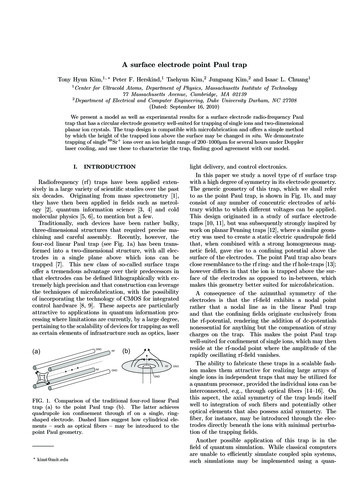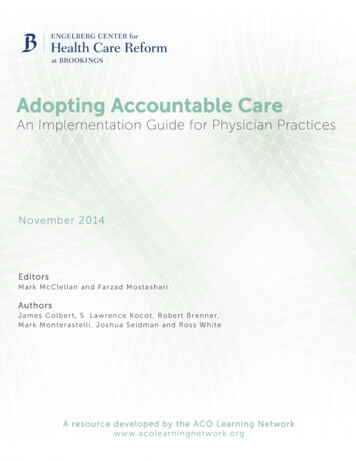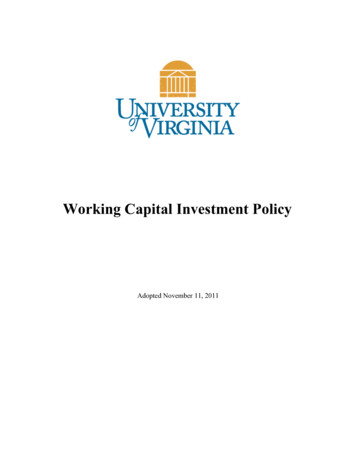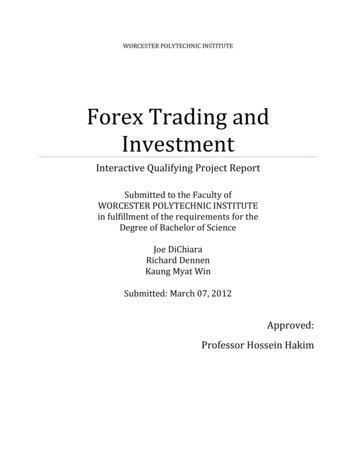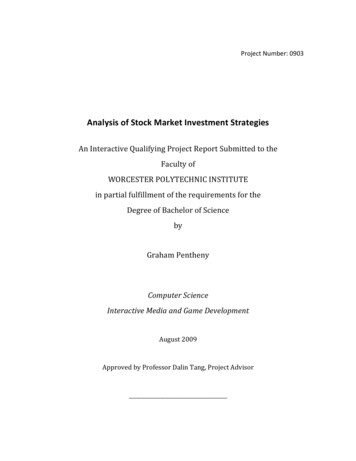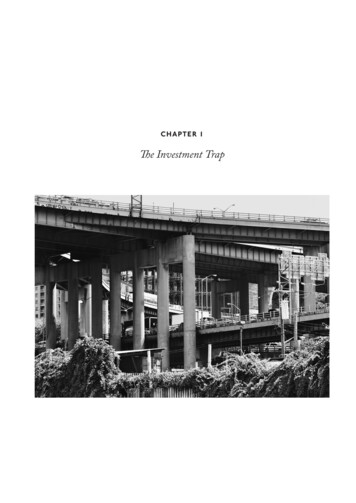
Transcription
CHAPTER 1The Investment Trap
and other countries face an impending investment disaster. Promising plans for city development and infrastructure are put aside for lack of funds. Often even the most necessarymaintenance lacks funding. Public resources for investments in infrastructure and ser vices are deeply constrained for reasons originating at thenational, state, and local level. The national government is adrift. Manystates are hostile or encumbered with debt. Local municipal finances areoften saddled with obligations.The funding crisis is much wider than just physical investment. Manycities are unable to invest in promising social development and trainingfor those among their citizens who are at risk of being left behind byglobalization or automation. One stark warning sign is the decreasinglife expectancy of lower-income white men in many U.S. cities.1 Aroundthe world, in much poorer cities, millions live in squalor, and publicinvestment in utilities and basic ser vices is dramatically underfunded.Th is matters because the 1.5 billion people who already live in theworld’s four thousand cities with a population above 100,000 will bejoined by additional billions in coming decades.2 Countries stagnate whentoo many of their cities fail to build economic, social, and human wealth.In spite of the many eyesores that meet strollers on city streets, urbanagglomeration is often hailed as one of mankind’s most impor tantfulcrums for human development. 3 But such progress does not comeMANY CITIES IN THE UNITED STATES3
automatically with population growth. While some cities spearheadhuman and economic advance, many others simply do not pull their weightor provide good quality of life for their citizens and their countries. Oftencities find themselves administering the results of poverty and crumblinginfrastructure. Instead, they could be investing in smart solutions thatimprove lives at an affordable cost— a lower cost than what is generallyconsidered possible. They could become “smart cities.”Smart cities can become growth engines that boost both their inhabitants’ quality of life and their country, even when national governmentsfail them. Smart cities provide ladders for their inhabitants where othercities leave them untended or even create chutes (trap doors). The differencebetween the ladder and the chute cities is so glaring—is so important forthe children who grow up in them and therefore for human development—that understanding what successful cities do is critical. In fact, helpingmore cities to build social and economic wealth may be the most promising route to national success. After all, essentially all currently rich countries with high average incomes and living standards were initially pulledalong by pioneering successful cities, and many still are. For example,London, New York, and Hamburg were locomotives for their countriesand still are.We start this book by taking a fresh look at what separates what wecall wobbling “treadmill towns” from blooming “turbo cities.” Cuttingthrough the mountains of myths, hypotheses, excuses, and self-servingcontentions, we find a robust dividing line between the flailing and thehealthy conurbations. Treadmill towns cannot get off the fiscal treadmillof living from hand to mouth, budgeting from tax revenues directly topublic consumption—not unlike hunter-gatherers. Often these cities haveassets that are hidden or locked into inefficient uses. The lack of longterm perspective keeps cities from developing them and putting themto work.In contrast, turbo cities, like turbo-charged engines, generate morepower from the resources they have. These cities have, at least in periods,invested in their economic, social, and human assets, and they keep developing them. Like investors, they can often flourish on the yield fromprevious good investments. As turbo cities continue to unlock their assets4THE PUBLIC WEALTH OF CITIES
and put them to good use, they become engines for growth and quality oflife for their citizens.A focus on asset governance makes all the difference for cities’ success.In fact, we claim that putting city assets to better use could self-financea remarkable boost in infrastructure investment, perhaps even double it.Furthermore, a canny asset strategy can increase household incomes bymuch more than, say, minimum wage laws ever can, and mitigate manyof the social ills that plague too many cities.The coming decades also offer cities an extraordinary menu of investment opportunities in digital technology. Some can generate enormousvalue, and not just in cutting administrative costs. According to somestudies the wise use of digital technologies could provide people in needof care with much better-quality care and ser vices at two-thirds of currentcost.4 As another example, local transport with self-driving cabs couldreduce the number of private autos and free up 25 percent of road space,very valuable space often owned by cities and towns. Also, paving the wayfor thriving innovations hubs in cities can boost incomes and tax revenue.But these opportunities are the gold nuggets in a menu that also contains many duds: technologies that don’t work, do not spread, or are implemented poorly. Only cities with a professional approach to asset governancewill be able to cherry-pick skillfully among investment proposals.To some city leaders a focus on unlocking public wealth may come naturally. For most it does not. Yet city politics, administration, and institutions can be shaped to develop a knack for governing public wealth. Weoffer a practical guide to developing cities’ social, human, and economicassets, and to designing institutions for professional caretakers of cityassets. In fact, we argue that less political meddling in the governance ofpublic wealth actually strengthens democracy.RIC H C IT Y, POOR C IT YCities do many things. Each has its array of flagship programs, awards,showcase projects, and slogans whose purpose is to propound uniqueselling points. Alas, most cities also have a plethora of fi nancial blackholes, deadbeat programs, and political stalemates. Th is concoction isTHE INVESTMENT TRAP5
frustratingly difficult to interpret. Are all the good initiatives sufficientto compensate for the mishaps? How can one even tell?While the net effects of a city’s recent policies are hard to assess, it iseasy to see that some cities are blooming and others are not. Some keepboth their citizens and their finances healthy and wealthy, without closing doors to newcomers. In others, debts pile up, and some neighborhoodsdeteriorate while others become unaffordable to most. We argue in thisbook that there is a dividing line between winning cities and totteringones that is rarely formulated explicitly. Yet it is intuitively quite obviousand is similar to the difference between success and stagnation for individuals or corporations.For most people, born without a silver spoon in their mouths, the earlyadult years of life demand emphasis on gaining employment and a wage.Part of this income is set aside over time and accumulates into assets.Later in life, the importance of a person’s savings—his or her balancesheet—grows. The quality of housing, ability to invest in children’s education, and ability to handle shocks hinge more on accumulated assetsand returns than on current income.Some people are much better than others at building assets, and notjust because they have higher incomes. In a widely read book, Rich Dad,Poor Dad, Robert Kiyosaki and Sharon Lechter argue entertainingly forhow a focus on building assets early in life and managing them well toearn a return makes a big difference in peoples’ ability to move from the“rat race to the fast track,” that is, moving from consuming out of currentwages to having more of one’s consumption covered by asset yield.5 Having been raised by two fathers, Kiyosaki compared their two differentapproaches to life. His educated dad advised him to work for a wage. Hisrich dad advised him to consume little and invest more and end up payingwages to employees. Both life paths required education, but the subjectsof study were completely different. His educated dad encouraged Robertto be a knowledgeable person. His rich dad encouraged Robert to knowhow to invest wisely, hire smart people, and use the right tools.A similar logic applies to companies. Many of today’s multinationalretailers such as Walmart, Tesco, and IKEA were able to build up a vastportfolio of real estate assets to serve their expansion of retail outlets. As6THE PUBLIC WEALTH OF CITIES
the retail industry is shaken up by globalization and online retail, theselegacy firms can fall back on their real estate cushion when necessary torevamp their business model and prosper again.A similar logic also shapes the fate of cities. Even poor cities usually siton a gold mine of assets that are not being used well or developed. Theseinclude real estate, municipal firms such as utilities and bus companies,and commercial ventures that cities often own. Cities that have a goodunderstanding of the assets they own and that govern them well to helpdevelop the city and earn a return, can spend and invest more withoutraising taxes. This would be comparable to Wall Street working for MainStreet rather than the other way around. They will not be shaken by recessions or pension debt, which can push less well-organized cities to thebrink of bankruptcy.This may seem trivial. But in fact, cities rarely have a good understanding of the assets they own. And they rarely manage them with an eyeto long-term value creation. Yet having this perspective makes all thedifference.The totality of a city’s assets comprises not just money in the bank orreal estate, but also social and human assets. A city that makes the rightkind of long-term social investments can face lower costs twenty yearsdown the line. For example, an intensive program to help school beginners at risk may reduce social costs resulting in unemployment, crime, ordrug addiction decades later. Such a delay between social investment andsocial return will be easily accepted in a city that focuses on developingthe long-term value of its assets, but risks being rejected in cities that arepreoccupied with making ends meet during the coming budget year.A focus on assets changes how cities think of education. Rather thancounting years of schooling or the share in the population of thecollege-educated, the impor tant question becomes, what value do citizens’ knowledge and skills have? That shifts focus to the quality ofeducation, specifically: how well does education and knowledge matchemployers’ needs? And how can more employers be attracted that demandthe skills that inhabitants have?Some very successful cities around the world, such as Singapore, havebuilt public economic, social, and human wealth out of seeminglyTHE INVESTMENT TRAP7
nothing—without help from circumstances, such as natural resources oreconomic trends—while their surroundings remained poor. Althoughcities are certainly affected by their surroundings and circumstances, theyare not slaves to them. Their fortunes are largely of their own making.Today, comparing Singapore with, say, Jamaica, or with Jamaica’s capitalof Kingston, appears completely unreasonable, even though both smallcountries became independent from Britain in the same year and wereinitially equally poor.While some cities, like Kingston, never developed their assets well,others have stumbled more recently. A city like Detroit was not just thelatest victim of deindustrialization but also very much of poor governance of its assets. We will show examples of cities around the world thatlost as many industrial jobs as Detroit, but now are doing better than ever.The difference is that Detroit over long periods administered its affairsfrom hand to mouth. Much of its wealth, and its debts, remained hiddenand did not show up in any accounts.Detroit, like most local governments, sits on unexploited gold minesway beyond the obvious well-known official buildings in the city center,or operational assets such as the local airport, harbor, and railway station,or utilities such as water and electricity. Underneath this tip of the iceberg cities usually own less obvious real estate assets, often portfolios ofbuildings for now outdated needs, such as telephone exchanges, postoffices, or administrations that nowadays should be automated and onthe Internet. Undeveloped land and brownfield spaces, if professionallymanaged, can be transformed into attractive and valuable assets, as canthe land around and above railway tracks and stations.Cities are often much wealthier, in terms of public assets, than nationstates, but their holdings remain strangely opaque and largely ignored.U.S. cities are home to more than 90 percent of the country’s GDP andown vast portfolios of commercial assets, greatly in excess of their debts(which can be quantified as the 3.7 trillion debt market in municipalbonds). Even poor cities own large swaths of poorly utilized real estate,utilities, and other commercial assets.Since the early twentieth century, a polarized and polarizing debatehas pitted privatization against nationalization. We don’t propose sneaky8THE PUBLIC WEALTH OF CITIES
ways to open the door to turning museums and libraries into amusementcenters, or the City Hall into a bowling alley. It is time to stop focusingon this phony war about ownership, and instead focus on the quality ofasset management.Developing city real estate and other assets is also an indispensabletool for creating human and social value: innovation hubs instead ofdecaying city centers, a healthy mixture of high- and low-cost housinginstead of segregated communities, proximity to workplaces instead of longhaul commutes. These are dimensions of city development that turn outto make a big difference to many city dwellers’ life prospects.Our calculations suggest that achieving a reasonable yield on publiclyowned real estate and other commercial assets could free more resourcesthan total current investments in infrastructure, including roads, railroads,bridges, water, electricity, and broadband put together. In other words,most cities could double their investments in infrastructure with smarteruse of their commercial assets. Unlocking public assets should be a coreurban renewal strategy.C ITIES ARE THE LOCOMOTIVES OF NATIONSDysfunctional national governments have become a cliché across the developed economies in Europe and the Americas. Often unemployment,inequality, and poor schooling, housing, or health care emanate frompolitical failures at the national level. Even in rich countries such as theUnited States, faith in the political system and the social contract appears to crack in the face of actual social deterioration such as the remarkable decline in labor market participation among white men. In spite of ahealthy recovery from the 2008 financial crisis the U.S. employment rateremains considerably lower than in the year 2000, in fact lower thanthat of France, and productivity growth is anemic. Many economists pointout that the kind of national policies that are important to encouragegrowth and social progress have seen very little reform for decades.6Cities are also hostage to national policy failures such as lagging infrastructure investments, regulatory deadlocks, and misdirected social policies. Therefore, much of economists’ research has focused on the effect ofTHE INVESTMENT TRAP9
nations and national policy on growth and development. For example,Daron Acemoglu and James Robinson recount vividly in their famousbook Why Nations Fail how the town of Nogales is poor on the Mexicanside of the border and relatively much better off on the U.S. side of theborder.7Yet such illustrative comparisons also miss an impor tant point. Inmany respects the people who live in and run their cities form their ownliving and working conditions. Some cities can actually fi nd creativeways to untangle themselves from the shackles of national policy thatwould other wise hold them back. In some cases they manage to becomemore like city-states, which have always had to rely on their wit and economic acumen to survive and prosper in hostile environments, such asancient Athens and Sparta, or medieval Florence and Venice.Consequently, it should be no surprise to find fairly well-off and destitute towns close to each other within the same country. For example,Detroit is often described as a city that was hit by deindustrializationand therefore lost half its population. Yet many other cities that were hitby deindustrialization have adapted more successfully, such as Akron,Albany, Raleigh-Durham, Minneapolis–St. Paul, and Portland in theUnited States. In Europe, some cities, such as Munich, have lost as manymanufacturing jobs as Detroit, but nevertheless are blooming.A more accurate diagnosis of Detroit’s ills is that it is an extreme example of a city that did not stop digging when it found itself in a ditch.Many of its inhabitants moved to more successful suburban cities thatsurround Detroit. The overall population of the larger urban area haschanged little over the past decades.If the United States had been dominated by cities that acted likeDetroit, its overall growth might have turned out to be more like Italy’s.There, GDP growth and incomes have flat-lined for the past two decades,as too many cities seem incapable of fi xing even basic ser vices such asgarbage collection. In fact, recent studies that we will review later makea convincing case that cities that build their social and human assets experience significantly better employment and income growth by lifting theircurrent inhabitants, not just by attracting high-income earners fromelsewhere.10THE PUBLIC WEALTH OF CITIES
Surprisingly, some U.S. cities with impressive economic growth stilldo little to raise national U.S. growth, according to a recent thoroughgoing study.8 The reason for their disappointing contribution is that thesecities grew more by attracting already successful people and putting themto work in high-productivity industries. But these cities performed waybelow their potential in terms of lifting resident middle-income or poorpeople into jobs with higher productivity. National GDP would be nearly10 percent higher, the study concludes, if New York, San Francisco, SanJose, and other cities like them had developed their assets in ways thatmade them more accessible to average earners to the same extent as themedian U.S. city.9Even booming cities could often do even more for national growthand balancing out weaker communities. For example, Stockholm, the capital of Sweden, does extraordinarily well by most measures, but it couldcompensate even better for smaller towns’ faltering industrial growth.Smaller towns’ traditional manufacturing firms are reeling from the world’smost demanding environmental and labor regulations and highest marginal income tax, which has left Sweden’s industrial output, mostlyspread out in towns all over the country, trailing far behind that of its maintrading partner, Germany. But this has been more than compensated forby a booming digital growth sector in Stockholm, which is happily unfettered by environmental and union demands. Stockholm, with just afifth of the country’s population, contributes half of the country’s productivity gain and is the fastest-growing metropolitan area in Europe.10This is not just a large-city effect. The other two larger Swedish cities,Malmö and Gothenburg, are doing noticeably less well. The main reasonfor Stockholm’s leading edge appears to be that many of the municipalities that make up the Stockholm region also top the league in providinggood schooling and a good business environment. Yet, Stockholm also hasan Achilles heel, an unwillingness to open for enough building of newresidential housing. Without that brake on growth, Stockholm mightbe Europe’s answer to Silicon Valley, and would contribute even more tooverall national growth.The drag on national growth owing to cities that do not live up to theirpotential is much larger in, for example, Italy, where many cities imposeTHE INVESTMENT TRAP11
a burdensome bureaucracy on top of national regulations. In anothercountry, India, many cities seem willing to do what is needed to boostgrowth, but Indian democracy locates too much power at the state levelrather than the city level. State governments are often dominated by thechoices of rural voters, leaving cities less room to control their owndestinies.One reason that the role of cities’ varying success for national growthhas been ignored is that research on the role of cities has largely focusedon so-called agglomeration effects. It has been easy for researchers tocorrelate the size of cities with subsequent growth. Th is has made it appear as though city growth is mainly a result of agglomeration—the roleof agglomeration is viewed almost like a natural law. Studies in bothdeveloped and developing countries do find that wages and productivityrise faster in larger cities.11 Causality of course goes both ways, andthere is a chicken-and-egg aspect to the issue. Some cities grow largerbecause they are better organized and more innovative. These cities attractmore workers—in particular, the most productive ones.But size is hardly the most important factor. In fact, many large citiesare by no means overachievers in economic vibrancy. A recent WorldBank study finds that cities vary enormously when it comes to their economic performance.12 Twenty-eight percent of cities grow more slowlythan their countries, while the top 10 percent of cities increase their GDPat almost three times the rate of the remaining 90 percent. The reportfinds that this is no accident. Cities that drive national growth take ahost of constructive initiatives that slow-growth cities do not. SiliconValley, and the cities it spans, is an extreme example of a region that is agrowth engine for the rest of the country—a turbo region—and is knownthe world over. But there are many other turbo cities that are not as wellknown. Some international examples are Kigali in Rwanda, Saltillo inMexico, Meknes in Morocco, and Coimbatore in India. Conversely,some cities that have been drags on their country’s growth would beGlasgow in Scotland (at least until recently) and Mt. Isa in Australia.In sum, some cities can do much better than others, and in fact canpull their countries along toward better growth and social development.Successful cities seem to be able to compensate for many of the policy12THE PUBLIC WEALTH OF CITIES
errors of their national and federal governments. National growth andquality of life, we argue, hinge on prospering cities.So how do thriving cities do it?THE TURBO C IT YGiven the widely varying fortunes of cities, one might expect to be ableto access a large body of research that provides clear evidence and recipesfor turning cities around. Alas, this research is minuscule. Most narratives about the success of cities are based on anecdotal evidence, notactual research.13Academic economists have often been guided by a presumption, perhaps a prejudice, that national policies determine growth and developmentwith only a marginal role for local policies. We think this is a questionablestance, as we noted earlier.More important, the connection between a city’s policies and howwell it is doing turns out to be unexpectedly difficult to prove statistically.One source of confusion in the attempt to understand true causes andeffects is that as with a self-playing piano, the music continues to playonce the mechanism has been cranked up. A city that has built its assetsat one point in time can continue to enjoy the music for years or decades.When it comes to cities, “Nothing succeeds like success.” Assets continue to generate a yield, even in periods when their management or citypolicies are less inspired.Our term for this kind of city is a “turbo city.” A turbo, or turbocharged, engine uses energy from its exhaust to help inject fuel into thecylinders, rendering the engine leaner and more powerful. Similarly, aturbo city has made canny investments that make its daily operationcheaper and more effective and sometimes even yield a direct return. Thisprovides economic muscle for further investments.For example, a town that has managed to attract some high-techstart-ups may see these grow for decades thereafter, attracting more techwizards that start more firms. Similarly, a city that at one time fosteredmany local entrepreneurs finds that these provide good models, entrepreneurship know-how, and capital to young people starting new firms.THE INVESTMENT TRAP13
As another example, a city that has managed to establish social normsthat are positive to education and respect for the law has “social assets”by which citizens influence each other. Parents emphasize law-abidingbehav ior to their kids. Neighbors keep an eye on each other. Crime ratesremain under control.All these things build up over long periods and take on a life of theirown. Cities that succeed in this way have lower costs for social ser vicesand employment ser vices. They may earn higher tax revenue. If the economic competence of their citizens spills over to city administration theymay find it easier to maintain good programs and put the city firms,utilities, real estate, infrastructure, and other wealth to good use andmanage pension funds well. Putting all this together, they can maintainbetter ser vices with lower taxes.Such a city is a humming engine with an unstoppable momentum.City politicians really have to kick and abuse it to make it stop running.THE TREADMILL TOWNQuite the opposite happens in a city on the brink of ruin. Debts havepiled up and pension liabilities and budget costs skyrocket in relation toincome from taxes and assets. Taxes need to be raised to pay bills, not toimprove ser vices. People with better options move out, further erodingthe tax base and entrepreneurial talent. Higher unemployment and crimerates require high costs in social programs just to handle acute situations.Such a city finds itself on a treadmill. It has to work hard just to stay inplace and make ends meet. There are no resources to invest in big changes.A city on the treadmill is also a fragile city. When a treadmill town doestry to mend its ways it finds that things may get worse before they getbetter. Closing the budget shortfall and paying down debts may requirecuts in ser vices that make the city less attractive in the short run. Thismay erode political support for reforms and push the city back onto thetreadmill, even if current bills have been paid.For example, when New York City narrowly escaped bankruptcy in1975 with the aid of a federal loan and concessions by city unions on pension cutbacks, the first order of business was serious budget cuts: over the14THE PUBLIC WEALTH OF CITIES
next three years, the number of police officers and teachers each droppedby about 6,000 and the number of firefighters by about 2,500, transitfares were raised, and tuition was imposed for the first time at the CityUniversity of New York. These cuts added an extra economic burden andpolitical uphill battle for efficiency-oriented reforms. It took great effortand skill to implement some of these reforms, which laid the foundationfor New York’s much improved development in recent decades.Today Rome finds itself in a similar bind as New York in 1975. Afterdecades of mismanagement, a new leadership has to handle an acuteeconomic crisis and cutbacks while trying to tackle long-term reforms atthe same time.These mechanisms also explain why researchers have found it sofrustratingly difficult to show which policies actually lead to better outcomes. The actions that turned one city into a turbo city and forced anotheronto the treadmill may have been taken many years earlier. Even for votersthe nexus between good policies and city success can remain muddled.And it’s not just the time lag. The key issue is that a city’s successlargely depends on whether it has accumulated assets that remain productive over time. One can think of a human settlement by a creek thatprovides drinking water. The dwellers can drink when there is water, buttheir existence is fragile. The creek can dry up and force them to move orfetch water from afar.Now suppose the dwellers build an asset, a water reservoir, wherethey accumulate water. Now they are less dependent on what the creekprovides in any particular month. Even more important, the reservoirprovides additional yield in the form of fish and water management thatallows fields to be irrigated as well.Th is, in short, illustrates the secret of turbo cities. The assets theyhave and put to good use not only keep them in good financial shape, evenin periods when they do not pursue any particularly enlightened policies,but the cities may also reap additional benefits through the improvedhealth and social well-being of their residents.So, what are these assets? The easiest to define are the economic assets.We identify two types of economic assets, commercial and policy assets,depending on how they are funded. Policy assets are tax funded toTHE INVESTMENT TRAP15
Box 1-1. Public Commercial AssetsCommercial assets are economic assets or operations that generate non-taxrevenue or could do so if properly structured and used.Typical commercial assets include the following: Incorporated enterprises in various sectors, typically providing servicessuch as energy, water, waste, and transportation Noncorporatized activities and services, such as utilities, parking, naturalresources, air rights, and broadband spectra Real estate, developed and undeveloped, currently used by public entitiesor third parties Infrastructure that is toll-based (such as a highway or bridge) or related toa private-public partnership (such San Diego’s Petc
In a widely read book, Rich Dad, Poor Dad, Robert Kiyosaki and Sharon Lechter argue entertainingly for how a focus o



